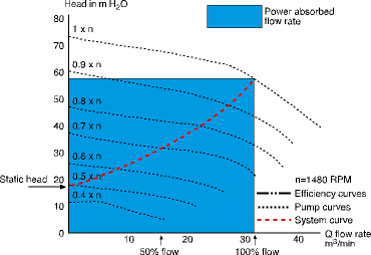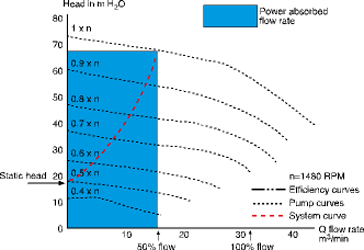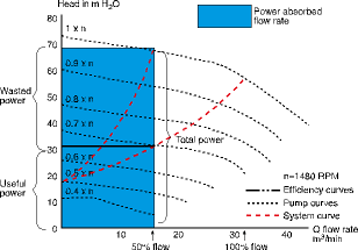

Increasing pump efficiencies with the Power Electronics SD-700 variable speed drive
Equipped with a fully developed built-in pump control algorithm, the SD-700 brings simultaneous energy savings and improved process control levels to applications where pumping is required.
Throttling inefficiencies
Pump throttling has never been an efficient or cost-effective method of flow-control. In most pump systems, the installed capacity of the pump and motor exceeds the normal operating requirements of the load. This is because the system must be sized to deliver the peak requirements, even though these peaks occur only occasionally. This results in the pump running at a reduced load for long periods of time. Pump throttling is often used as a means of maintaining loading on the pump or to control flow rates.
In a throttled system, although the delivery requirement is below the peak capability of the pump, the load on the motor, and thus the power drawn from the mains supply, is not reduced by the same margin.
A typical pump curve (Figure 1) is shown for a fixed speed pump in a variable flow application. With the operating point shown at 100% the power consumed is indicated by the shaded area under the graph. With an SDF-700 VSD installed and running at the operating point of 100% there will be no practical efficiencies gained.

However, in a situation where the consumer only has a requirement for half of the pump’s capacity (Figure 2) the power consumed is indicated by the shaded area under the graph. At reduced load the SD-700 shows a marked difference and this can be clearly evidenced in Figure 3. This clearly shows the SD-700 power draw superimposed on the throttled system’s power draw. The marked difference in power saving is an inherent feature when operating a pump with a variable speed drive (VSD).


The pump control algorithm
While most VSDs provide increased efficiencies compared to pump throttling, good process control demands that the VSD should have a sophisticated embedded pump control algorithm. This can often mean the difference between installing a multitude of external control equipment, or just the VSD itself. In order to do this, the VSD should include the ability to directly accept a pressure or flow sensor and automatically regulate the motor speed based on demand.
The no-demand condition must also be catered for. Due to the vast differences in pump curves and system configurations, a single preset speed may not always capture the no-demand condition. It is better to have a variety of options available.
Factors, such as motor current, pressure monitoring, flow sensing or a combination of these will be required. This will ensure the no-demand condition can be detected across a broader spectrum of control applications and across a greater variety of installations.
Other important control factors such as detecting a pump out of service, pipe fill function, flow measurement by pulses, cavitation protection with reset activation time, zero flow detection, and three types of pump alternation modes are standard features on the SD-700.
Starting
The starting of a pump can also be optimised by the VSD. For Example, if the pump is starting into an empty pipe, there is no benefit to be gained by immediately trying to regulate pressure via built-in PID control. The SD-700 pump algorithm will detect the empty pipe condition and run through a pipe-filling routine and then bring the system up to pressure in a controlled fashion.
On the other hand, if the pump is automatically starting after a period of no-demand, it should immediately accelerate up to the region of the pump curve and commence regulating.
The pump algorithm also detects fault conditions in both the hydraulic system and the motor.
For hydraulic fault conditions, such as: high or low pressure and cavitation; the SD-700 will respond as an intelligent pump controller. Conditions such as high pressure after start-up or cavitation are transitory. Therefore, as soon as the protection is activated the condition is unlikely to last for any length of time. The SD-700 will try to restart after the condition has normalised, or in the case of cavitation, after a specified time has elapsed. Other conditions such as a burst pipe or repeated cycling are regarded as terminal, and the unit will not restart after the protection has operated.
For electrical and motor related faults the VSD incorporates fault preventing algorithms (FPAs), which allow it to overcome certain critical conditions without activating internal protection monitors. This helps to prevent unnecessary tripping. However, severe faults will trigger the correct protection and the inverter will inhibit starting. Optional GSM or GPRS communication is available for fault signalling.
Electro-magnetic compatibility
Many variable speed drives are only capable of up to 100 m of screened cable on the output, with several being limited to as little as 30 m before losing their EMC compliance. By deliberately adding filters in the IGBT driver stages and slowing down the IGBT rise times (lower dv/dt time), Power Electronics has been able to reduce motor cable capacitance and RFI harmonics to the point where these problems are almost completely eliminated. This allows motor cables up to 300 m long to be connected. The reduced motor winding and cable stress also ensures longer motor life.
All SD-700 Series drives are factory fitted with EMC and harmonics input filters as well as output motor chokes. AC mains input stages are 6 pulse as standard, but 12 or 18 pulse input connections can be specified. With 12 or 18 pulse input configurations, the generation of AC ripple-current harmonics is almost completely eliminated.
Power Electronics SD-700 Series of inverters are available from 2,2 kW to 1,8 MW in various voltage ranges, 380–525 V a.c. or 550–690 V a.c. From 55 kW upwards, the inverters are available as free standing units and are available in IP20 or IP54 enclosure configurations. Full output at 50°C is guaranteed and all inverters are covered by a 3-year factory warranty.

© Technews Publishing (Pty) Ltd | All Rights Reserved